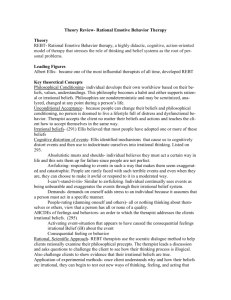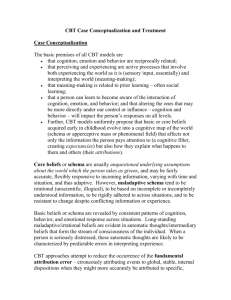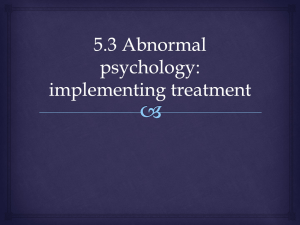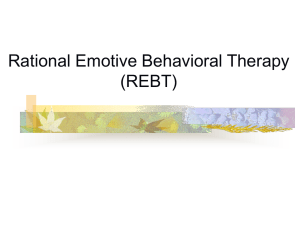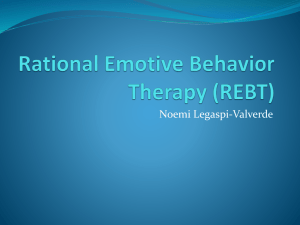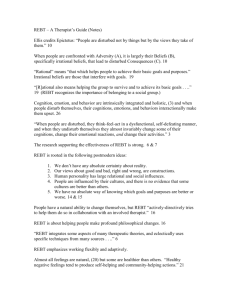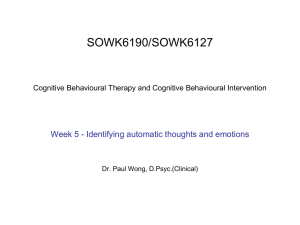Powerpoint Chapter 10
advertisement
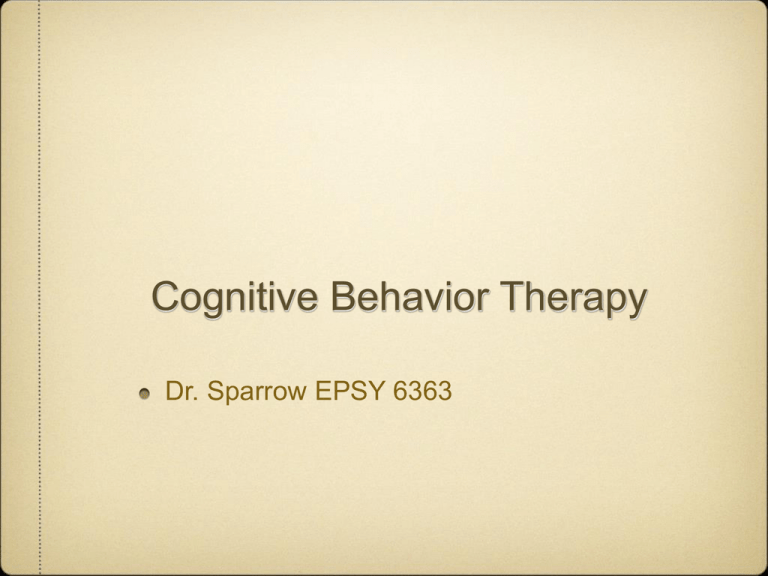
Cognitive Behavior Therapy Dr. Sparrow EPSY 6363 Founders • Albert Ellis -- Rational Emotive Behavior Therapy (REBT) originated in mid-1950s • Aaron Beck -- Cognitive Therapy (CT) • Donald Meichenbaum -- Cognitive Behavior Therapy (CBT) The Common Ground • Collaborative relationship • Psychological distress originates in faulty cognitive processes • Changing cognitions will change feelings and behaviors • Short-term educational model • homework • client responsibility in and out of session • variety of technique Ellis’s REBT • Thoughts, emotions and behaviors have a reciprocal cause and effect relationship • We do not need to be loved or accepted. • People are not disturbed by things, but the view they take of them • Adlerian: • • social interest • goals and purposes • teaching and persuasion Emotions follow beliefs, so therapy focuses mainly on changing beliefs Human Nature and Source of Distress • Humans are capable of rational lives, but also susceptible to faulty thinking • We are self-talking, self-evaluating, and self-sustaining • We mistake our preferences for essential needs Sources of Faulty Thinking • Significant others • Our own thought processes -- superstitions and dogmas • Assumption that we need acceptance • Assumption that there’s someone or something to blame • Our preferences turn into shoulds and musts. A-B-C Theory of Personality • A is activating event • B is belief • C is emotional and behavioral consequence • D is disputing (either by therapist or client) -by detecting, debating, discriminating • E is effect of intervention, that is, an effective belief system or philosoph • F is new feeling Therapeutic Goals of REBT • Minimizing emotional disturbances • Acquiring more realistic philosophy • Acquiring unconditional self acceptance (USA) • Developing unconditional other acceptance (UOA) Therapist’s Function • Encourages and persuades client to change “musts” into preferences • Demonstrate how client is keeping emotional disturbance active • Helping client modify thinking • Challenge client to develop rational philosophy The Client’s Experience in Therapy • Learner • Doer • Expected to work outside session • Homework is carefully co-designed Therapeutic Relationship • Relationship is minimized • Therapist models UOA, encouraging clients to do likewise • Therapist discloses in order to model healthy imperfection • Transference is challenged as unnecessary, part of irrational beliefs Interventions of REBT • Cognitive • Disputing irrational beliefs • Doing cognitive homework, making lists of problems, detecting absolutist beliefs and disputing them. • Client is expected to take risks to overcome negative expectations. • Changing one’s language • Using humor, laughing at oneself Interventions of REBT, continued • Emotive Techniques • Rational emotive imagery-- imagining worst case scenarios and feeling appropriate reactions • Role playing -- noting specific beliefs and feelings that arise as evidence of irrational philosophy • Shame attacking exercises, going counter to usual efforts to win acceptance • Use of force and vigor, role playing with therapist Interventions of REBT, continued • Behavioral Techniques • standard behavior therapy techniques, such as operant conditioning, systematic desensitization, etc. • Research Efforts • technical eclecticism makes research difficult. Aaron Beck’s CT • Similar to REBT in that focus is on changing faulty thoughts and beliefs • But CT is based on three tenets. • Client’s internal dialogue can be accessed through introspection • Beliefs have highly personal meanings, so therapist can’t presume to know what’s best. • These meanings have to be discovered by the client. • By accessing cognitive content of upsetting experience, therapist can work with restructuring underlying “core schema.” Aaron Beck’s CT, continued • Cognitive distortions • arbitrary inferences -- conclusions that are without supporting evidence • selective abstraction -- forming conclusions on the basis of one detail • overgeneralization • magnification and minimization • personalization • mislabeling • polarized thinking, all-or-nothing, either-or Differences Between REBT and CT • REBT is highly confrontive and focuses on teaching role of therapist. Beck uses an inquiring method. • Disputes Ellis’s method of confronting irrational beliefs, believing that people think they are being rational. • Beck prefers collaborative empiricism, arriving at the facts together, so that confrontation can be based on discovery, rather than on therapist’s impressions. • Beck prefers to see problems as a misapplication of underlying rules that may be okay. Beliefs are not so much irrational as interfering. Therapeutic Relationship in CT • Much more emphasis on quality of relationship • Therapist functions as catalyst and guide • Client expected to take an active role • Therapist’s teaching role minimized in favor of supporting client’s role in self discovery • Client becomes her own therapist Applications of CT • Applying CT • Helping clients become aware of automatic thoughts (cognitive distoritions) • Helping clients make alternative interpretations Applications of CT, continued • Treatment of depression: It’s basis: • 1) negative self concept • 2) interpreting experiences negatively • 3) projection of negativity into future • Treatment of depression: Interventiosn • Getting client to do something • Pointing out “tyranny of shoulds” • Breaking tasks into manageable units to offset tendency of depressed persons to exaggerate the obstacles Meichenbaum’s Cognitive Behavior Modification • Self instructional training helps clients become aware of self talk • self observation • starting new internal dialogue • learning new “coping” skills practiced in real life situations Meichenbaum’s CBM continued • Stress management • stress innoculation • conceptual -- becoming aware of nature of stress and how they are responding to it, as well as creating it • skills acquisition and rehearsal -strategizing new responses • application -- transfer and maintenance of changes Contributions of REBT, CT, CBM • RBT • Confrontation is important • Action orientation • Becoming your own therapist • CT • Extremely effective for depression • focuses on client’s inner world -- existentialist Contributions of REBT, CT, CBM, continued • Meichenbaum • Like CT, based on educational model; dymystifies therapy • Encourages a working alliance • Empowers the individual Limitations of Cognitive Behavioral Approach • Ellis’s REBT • Denies past • Encourages misuse of power • Beck’s CM and Meichenbaum’s CBM • simplistic and superficial • emotions are overlooked • teaching isn’t only way learning takes place


